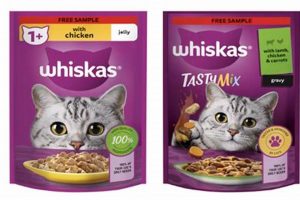Thai cuisine, renowned for its vibrant flavors and aromatic ingredients, traditionally incorporates elements that may contain gluten, a protein found in wheat, barley, and rye. Dishes prepared without these gluten-containing components allow individuals with celiac disease or gluten sensitivities to enjoy the diverse culinary landscape of Thailand. Examples include green curry prepared with coconut milk, rice noodles, and gluten-free soy sauce, or stir-fries featuring rice and vegetables seasoned with tamari.
The availability of Thai meals prepared in this manner expands dietary options and promotes inclusive dining experiences. Understanding the ingredients and preparation methods is crucial for ensuring adherence to specific dietary requirements. Historically, certain regions of Thailand have relied more heavily on rice-based staples, naturally lending themselves to gluten-free options. Awareness of potential cross-contamination in kitchens is also paramount.
The following sections will delve deeper into specific dishes, ingredient substitutions, and practical considerations for identifying and preparing safe and flavorful meals. Exploration of suitable alternatives and mindful ordering practices will empower individuals to confidently navigate the world of Thai gastronomy while adhering to their dietary needs.
Essential Guidance for Gluten-Free Thai Cuisine
Navigating Thai menus requires diligence to ensure compliance with a gluten-free diet. Awareness of ingredients and preparation methods is crucial.
Tip 1: Inquire about soy sauce usage. Traditional soy sauce often contains wheat. Request tamari, a gluten-free alternative, or verify that a gluten-free soy sauce is used in preparation.
Tip 2: Be cautious of noodle dishes. While rice noodles are inherently gluten-free, wheat noodles may be used in some dishes. Confirm the type of noodle used prior to ordering.
Tip 3: Scrutinize curry pastes. Some commercially prepared curry pastes contain gluten as a thickening agent or filler. Opt for freshly made curry pastes or verify the ingredients of pre-made options.
Tip 4: Exercise caution with fried items. Cross-contamination in shared fryers is a significant concern. Confirm that fried items are prepared in dedicated fryers to avoid potential gluten exposure.
Tip 5: Verify the absence of oyster sauce. Certain oyster sauce brands may incorporate wheat flour. Request confirmation from the restaurant regarding the ingredients used.
Tip 6: Communicate dietary restrictions clearly. Explicitly inform restaurant staff of gluten-free requirements to ensure awareness and appropriate preparation methods.
Tip 7: Consider dishes with naturally gluten-free ingredients. Soups like Tom Yum and Tom Kha, prepared traditionally, are often naturally gluten-free. However, always confirm ingredients due to regional variations.
Adherence to these guidelines facilitates a safer and more enjoyable experience when consuming Thai cuisine. Careful consideration of ingredients and preparation methods is paramount.
The subsequent sections will provide further insights into suitable dishes and ingredient substitutions to enhance the gluten-free Thai dining experience.
1. Ingredient Awareness
Ingredient awareness is fundamental to maintaining a gluten-free diet while enjoying Thai cuisine. Thorough understanding of common Thai ingredients and their potential gluten content is critical for preventing unintended exposure. Vigilance is required due to the prevalence of hidden gluten sources in seemingly safe dishes.
- Soy Sauce Composition
Traditional soy sauce is typically fermented with wheat, making it a primary source of gluten in many Thai dishes. Understanding this necessitates seeking alternatives, such as tamari, a soy sauce fermented without wheat, or ensuring that restaurants utilize gluten-free soy sauce varieties. Improper soy sauce selection can negate other gluten-free precautions.
- Curry Paste Analysis
Commercially prepared curry pastes can contain wheat flour as a thickening agent or filler. Examining ingredient lists meticulously is crucial. Opting for freshly made curry pastes or those certified gluten-free mitigates this risk. Inquiries regarding the specific brand and ingredients used are advisable when dining out.
- Noodle Type Identification
While many Thai noodle dishes feature rice noodles, wheat noodles are also prevalent. Accurately identifying the noodle type used in a dish is essential. Rice noodles, made from rice flour, are naturally gluten-free, while wheat noodles contain gluten. Clearly communicating noodle preferences is necessary to avoid confusion.
- Hidden Gluten Detection
Gluten can be present in unexpected ingredients, such as oyster sauce, certain fish sauces, and modified food starches used as thickening agents. Diligence in scrutinizing ingredient lists and questioning restaurant staff is imperative to identify these hidden sources. Awareness campaigns and transparent labeling practices can aid in this process.
The multifaceted nature of ingredient awareness requires proactive investigation and clear communication. Successfully navigating gluten-free Thai cuisine hinges on a comprehensive understanding of ingredient composition, potential cross-contamination points, and the availability of suitable alternatives. Continued education and vigilant practices are paramount for those adhering to a gluten-free diet.
2. Soy Sauce Alternatives
Soy sauce, a staple in Thai cuisine, presents a significant challenge for individuals adhering to a gluten-free diet due to its typical wheat-based fermentation process. Consequently, the selection of appropriate soy sauce alternatives is critical for safely enjoying Thai flavors while avoiding gluten exposure.
- Tamari: A Primary Substitute
Tamari, a Japanese soy sauce variant, is often produced without wheat, making it a suitable gluten-free replacement. However, confirming the “wheat-free” designation is essential, as some tamari brands may include trace amounts. Tamari contributes a similar umami flavor profile to dishes and can be used in equal measure to traditional soy sauce in most recipes.
- Gluten-Free Soy Sauce: Certified Options
Several manufacturers produce soy sauce specifically formulated to be gluten-free. These products undergo processing to remove gluten or utilize alternative fermentation methods. Seeking certifications from recognized gluten-free organizations provides an additional layer of assurance regarding the product’s gluten content. Availability may vary based on location and retailer.
- Coconut Aminos: A Soy-Free Alternative
Coconut aminos, derived from the sap of coconut palm trees, offer a soy-free and gluten-free alternative to soy sauce. While the flavor profile is distinct, with a slightly sweeter and less complex taste, it can effectively replace soy sauce in certain applications, particularly stir-fries and sauces. Its lower sodium content is also a consideration.
- Homemade Substitutions: Control and Customization
Individuals can create their own soy sauce alternatives using ingredients like blackstrap molasses, balsamic vinegar, and fish sauce. This approach allows for complete control over ingredients and customization of the flavor profile to suit specific preferences. However, achieving a taste identical to traditional soy sauce may be challenging, and careful experimentation is required.
The judicious use of soy sauce alternatives empowers individuals with gluten sensitivities to savor the rich tapestry of Thai cuisine without compromising their dietary needs. Careful selection, coupled with informed ordering practices when dining out, facilitates a safer and more enjoyable culinary experience.
3. Noodle Verification
The nexus between noodle verification and gluten-free Thai food resides in the fundamental composition of noodles themselves. Many traditional Thai noodle dishes employ rice noodles, which are inherently gluten-free due to their derivation from rice flour. However, certain dishes may incorporate wheat noodles, introducing gluten and thus rendering them unsuitable for individuals with celiac disease or gluten sensitivities. Therefore, precise noodle verification becomes a critical step in ensuring a dish adheres to gluten-free dietary requirements. The substitution of wheat noodles for rice noodles is a common source of unintentional gluten exposure, underscoring the direct cause-and-effect relationship. For instance, a Pad See Ew dish prepared with wide rice noodles is typically safe, but if the restaurant substitutes wheat-based egg noodles, the dish becomes hazardous for those avoiding gluten. The importance of noodle verification is amplified by the potential health consequences of gluten ingestion for sensitive individuals.
Practical application of noodle verification involves direct inquiry with restaurant staff regarding the noodle type used in a particular dish. Phrases such as “Are the noodles made from rice flour?” or “Does this dish contain wheat noodles?” provide clarity. Examining the dish visually may also offer clues, although accurate identification often necessitates confirmation from the kitchen. Furthermore, familiarity with common Thai noodle dishes and their traditional noodle types can aid in informed decision-making. Restaurants catering to gluten-free diners may indicate noodle composition on their menus, streamlining the verification process. However, even with menu indications, confirmation is advisable to mitigate the risk of errors in preparation or ingredient substitutions. Consider a scenario where a diner assumes all Pad Thai dishes are gluten-free due to the presence of rice noodles in most variations; failing to verify the inclusion of wheat-based ingredients in the sauce can lead to inadvertent gluten consumption.
In summary, noodle verification serves as a cornerstone in navigating gluten-free Thai cuisine. Challenges arise from potential language barriers, miscommunication with restaurant staff, and the variability in preparation methods across different establishments. Addressing these challenges necessitates proactive communication, meticulous attention to detail, and a comprehensive understanding of Thai culinary practices. Ultimately, the accurate verification of noodle composition empowers individuals to confidently enjoy the flavors of Thailand while maintaining adherence to their gluten-free dietary restrictions, aligning with the broader goal of informed and inclusive dining experiences.
4. Cross-Contamination Risks
The intersection of cross-contamination risks and gluten-free Thai food represents a critical area of concern for individuals with celiac disease or gluten sensitivities. Cross-contamination, defined as the unintentional transfer of gluten from a gluten-containing substance to a gluten-free food, can negate even the most meticulous ingredient selection. This transfer can occur via shared cooking equipment, utensils, surfaces, or even airborne particles of wheat flour. Given the pervasive use of wheat-based ingredients in many standard Thai dishes, the potential for cross-contamination is substantial. For example, frying naturally gluten-free spring rolls in the same oil used to fry breaded items introduces a significant risk. This risk transforms a seemingly safe menu choice into a potential health hazard, highlighting the importance of understanding the mechanisms and prevention of cross-contamination.
Practical application of this understanding involves several key strategies. Explicit communication with restaurant staff regarding dietary restrictions is paramount, specifically requesting preparation methods that minimize cross-contamination. This may include asking for food to be prepared in a separate area of the kitchen, using dedicated cooking equipment, and ensuring that gluten-containing ingredients are not used nearby during preparation. Another strategy involves selecting dishes that are less likely to be exposed to cross-contamination, such as soups prepared from scratch rather than those using pre-made bases potentially thickened with wheat flour. Furthermore, careful observation of the restaurant environment, including the cleanliness of work surfaces and the presence of airborne flour, can provide additional insights into the potential for cross-contamination. In cases of uncertainty, selecting restaurants with established gluten-free protocols or those that are certified gluten-free may offer greater assurance.
In conclusion, the mitigation of cross-contamination risks forms an indispensable component of safely navigating the world of gluten-free Thai food. Challenges arise from variations in kitchen practices, language barriers, and the potential for miscommunication regarding dietary requirements. Addressing these challenges requires proactive communication, diligent questioning, and a thorough understanding of potential sources of contamination. The ability to effectively minimize these risks empowers individuals to confidently enjoy the flavors of Thai cuisine while safeguarding their health and well-being, fostering a more inclusive and accessible dining experience.
5. Hidden Gluten Sources
The pursuit of strictly adhering to gluten-free dietary requirements within the realm of Thai cuisine necessitates a thorough understanding of potentially obscure or unexpected sources of gluten. These “hidden” sources frequently elude initial scrutiny, presenting a risk of unintentional exposure despite careful menu selection and communication with restaurant staff. Awareness of these less obvious gluten contributors is therefore paramount.
- Modified Food Starch
Modified food starch, a common thickening agent, can be derived from wheat. It’s frequently employed in sauces, soups, and desserts to improve texture and consistency. The presence of modified food starch necessitates careful ingredient list examination or direct inquiry with restaurant personnel regarding its origin and composition. If wheat-based, an alternative dish should be selected.
- Oyster Sauce Formulation
Certain oyster sauce brands incorporate wheat flour to enhance viscosity and reduce production costs. This ingredient, often unlabeled, poses a significant risk. Prior to consumption, verification of oyster sauce’s gluten-free status is crucial. Tamari or gluten-free fish sauce can serve as suitable replacements in certain recipes, provided their ingredients are similarly verified.
- Pre-Made Marinades and Sauces
Commercially prepared marinades and sauces frequently contain gluten-based additives such as soy sauce, teriyaki sauce, or hydrolyzed wheat protein, each serving as a flavor enhancer or stabilizer. Evaluating the ingredient list is paramount; homemade alternatives offer control over ingredient selection. Direct communication with the restaurant regarding the provenance and gluten content of pre-made sauces is essential.
- Processed Meats and Seafood
Processed meats and seafood utilized in specific Thai dishes may contain gluten as a binding agent or filler. Meatballs, fish cakes, and imitation crab products require meticulous inspection. When these items are incorporated in meals, confirming their gluten-free certification is vital. Unprocessed, whole cuts of meat and seafood represent safer alternatives.
The recognition and avoidance of these concealed sources of gluten are instrumental in mitigating risks associated with gluten-free Thai dining. Due diligence in ingredient verification, coupled with informed ordering practices, is necessary to ensure adherence to dietary restrictions and the preservation of health and well-being.
Frequently Asked Questions
This section addresses prevalent queries regarding the identification, preparation, and consumption of Thai cuisine while adhering to a gluten-free dietary regimen.
Question 1: What are the primary gluten-containing ingredients to avoid in Thai food?
The primary ingredients of concern include traditional soy sauce (containing wheat), wheat noodles, and certain commercially prepared curry pastes that may contain wheat flour as a thickening agent.
Question 2: How can one identify hidden sources of gluten in Thai dishes?
Hidden sources can include modified food starch derived from wheat, oyster sauce, pre-made marinades, and processed meats used as ingredients in certain dishes.
Question 3: What are suitable gluten-free alternatives to soy sauce in Thai cooking?
Appropriate substitutes include tamari (a wheat-free soy sauce), certified gluten-free soy sauce, and coconut aminos. Ensure the chosen alternative is explicitly labeled gluten-free.
Question 4: What questions should be asked when ordering Thai food at a restaurant to ensure it is gluten-free?
Inquire about the soy sauce used (requesting tamari or gluten-free soy sauce), confirm the type of noodles (specifying rice noodles), and verify the absence of gluten in curry pastes and sauces. Also, ask about potential cross-contamination during food preparation.
Question 5: What measures can be taken to minimize the risk of cross-contamination in a restaurant setting?
Request that food be prepared in a separate area of the kitchen using dedicated cooking equipment and utensils. Specifically request avoidance of shared fryers.
Question 6: Are there specific Thai dishes that are typically gluten-free without modification?
Dishes such as Tom Yum soup, Tom Kha soup (coconut soup), and certain green curries prepared with rice noodles and gluten-free soy sauce can be naturally gluten-free. However, confirmation of ingredients is always recommended due to regional variations.
Awareness and proactive communication are critical for successfully navigating gluten-free Thai dining. By understanding potential gluten sources and employing careful ordering practices, individuals can confidently enjoy the diverse flavors of Thai cuisine.
The subsequent section will provide practical resources for identifying gluten-free Thai restaurants and recipes.
Conclusion
The preceding exploration has illuminated critical aspects of gluten free thai food. Key considerations include vigilant ingredient awareness, appropriate soy sauce substitutions, careful noodle verification, mitigation of cross-contamination risks, and identification of hidden gluten sources. Successful navigation of gluten-free Thai cuisine necessitates proactive communication and a thorough understanding of both culinary practices and dietary requirements.
The availability of accurate information and adherence to established guidelines are essential for ensuring safe and enjoyable dining experiences. Continued awareness and diligent application of these principles empower individuals to confidently participate in the rich culinary landscape of Thailand while maintaining dietary integrity and well-being. Further research and wider adoption of gluten-free protocols within the food service industry will continue to enhance accessibility and inclusivity for those with dietary restrictions.




![Best Gluten Free Fast Food French Fries [Guide + List] World’s Most Delicious Foods: Must-Try Dishes from Every Country Best Gluten Free Fast Food French Fries [Guide + List] | World’s Most Delicious Foods: Must-Try Dishes from Every Country](https://lisasfoods.com/wp-content/uploads/2025/12/th-787-300x200.jpg)


